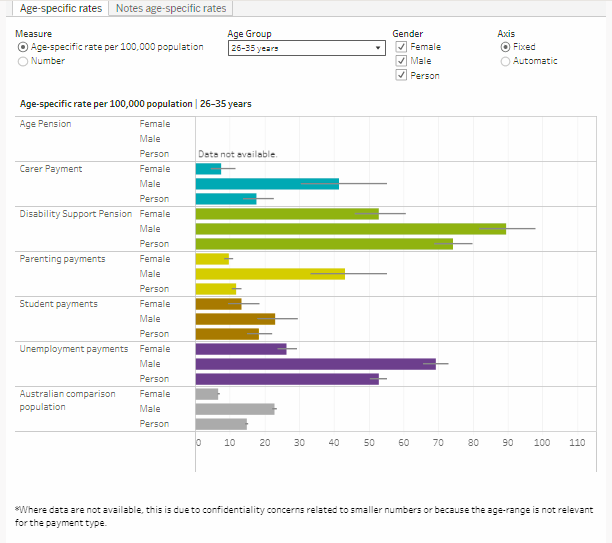The Northern Rivers Region of New South Wales had an estimated resident population in 2024 of 318,848 men, women and children, spread across 20,758 square kilometres with a population density of 15.36 persons per square kilometre. [https://profile.id.com.au/northern-rivers/]
The region's residents live in est. 252,350 households of which 29,314 — or est.11.6 per cent of all resident households — contain lone parents with their child/ren.
This percentage is higher than the total percentage for the state's entire regional zone and, represents an increase in Northern Rivers lone parent households of 15,535 over the five years between the 2016 & 2021 national censuses.
In March 2025 the University of Melbourne issued a media release covering aspects of the 20th Annual Statistical Report of the HILDA Survey.
An annual report funded by the Australian Government through the Dept. of Social Services, based on data collected in a longitudinal study over more than two decades, with the same 17,000 people interviewed year-on-year.
That media release stated three uncomfortable facts:
inequality is at a 20 year high in Australia, with higher incomes having grown faster relative to middle incomes. While at the same time, the relative growth of lower incomes has declined;
more than half (51.2%) of survey respondents reported that their real income decreased between 2021 and 2022; and
single parents remain the hardest hit by negative outcomes:
Across the broad spectrum of the survey and the report’s analysis, single parents are often the demographic that is the most negatively impacted by economic factors.
Single parents have seen a 76% increase in child care costs per child since 2006, compared to a 48% increase for couple parents.
Over the 2001-2022 period, single parents were not only the most likely family type to have poor mental health but also took the longest to recover from poor mental health.
With a poverty rate of 25%, single-parent families were significantly more likely to experience poverty, more than four times the rate for couple-parent families (6.2%). They also had the lowest average wealth levels.
The media release also confirmed that floods across Australia are causing spikes in household damage:
In 2022, the percentage of Australians that reported weather-related damage to their house reached a level not seen before in the HILDA survey.
Since 2009, the annual survey has asked participants whether “a weather-related disaster (e.g., flood, bushfire, cyclone)” had damaged or destroyed their home in the last 12 months. The 2022 results therefore included respondents impacted by the various floods across Queensland, New South Wales, Tasmania and Victoria during late 2021 and 2022.
As such, this latest wave saw much larger rates of home damage from weather-related disasters, jumping from 1.3% in 2021, to 4.5% the following year. This eclipses any rate seen before, almost 2 percentage points higher than the previous nationwide peak of 2.7% in 2011. This recent rise in weather damage hit those in the northeast of the country the most, with roughly 9% of respondents in New South Wales and 6% of Queenslanders affected.
This month the 20th statistical analysis, The Household, Income and Labour Dynamics in Australia Survey: Selected Findings from Waves 1 to 23, September 2025 was released. It can be found at:
This report presents select findings from Waves 1 to 23 of the HILDA Survey and explores 10 topics:
- Households and family life
- Household economic wellbeing
- The labour market
- Retirement
- Housing insurance
- Bodily pain
- Psychological distress
- Blood donation
- Friendships
- Time stress
Following release of the 20th annual report Barnardos Australia issued the following media release.
Media Release, 19 September 2025:
HILDA report reveals children trapped in poverty as inequality reaches crisis point
Australian children are being robbed of their childhood, Barnardos Australia says, as new research reveals that more than one in three children in single-parent families live in poverty.
Today’s landmark Household, Income and Labour Dynamics in Australia (HILDA) Survey shows more than one in three (36.2%) children in single-parent families are living below the poverty line, the highest level recorded since the survey began in 2001.
Research found 30 per cent of children in single-parent families have lived in poverty for more than two decades, but in 2022 the figure reached its peak at 36.2 per cent.
Single-parent households are almost three times more likely to be in poverty than households with two parents.
“This research reflects what Barnardos is seeing in the community. Housing costs are pushing children deeper into poverty, with many single-parent families living below the poverty line,” Barnardos Family Connect and Support team leader Michaela Bestwick said.
“When more than one in three children in single-parent families can’t afford basic necessities after paying rent, it is clear we’re facing a national housing and child poverty emergency that demands immediate action.”
Single-parent families have experienced a 76 per cent spike in childcare costs since 2006, the research shows, leaving many children without access to early learning opportunities.
“How can we break the cycles of poverty and disadvantage when families can’t afford to send their children to daycare?” Ms Bestwick said.
“Children experiencing poverty and instability are removed from their families not because of abuse or neglect, but because their parents simply can’t afford to provide basic necessities.
“The government must do more to ensure families are supported and children are given the opportunity to thrive and enjoy their childhood.
“When children can’t access early childhood education because a single mother can’t afford childcare, or when they’re forced to move schools repeatedly due to housing instability, or when they can’t concentrate in class because they’re hungry - we’re failing them at the most crucial time in their lives.
“Every day of disadvantage in a child’s life will have consequences for years to come.”
ENDS



















